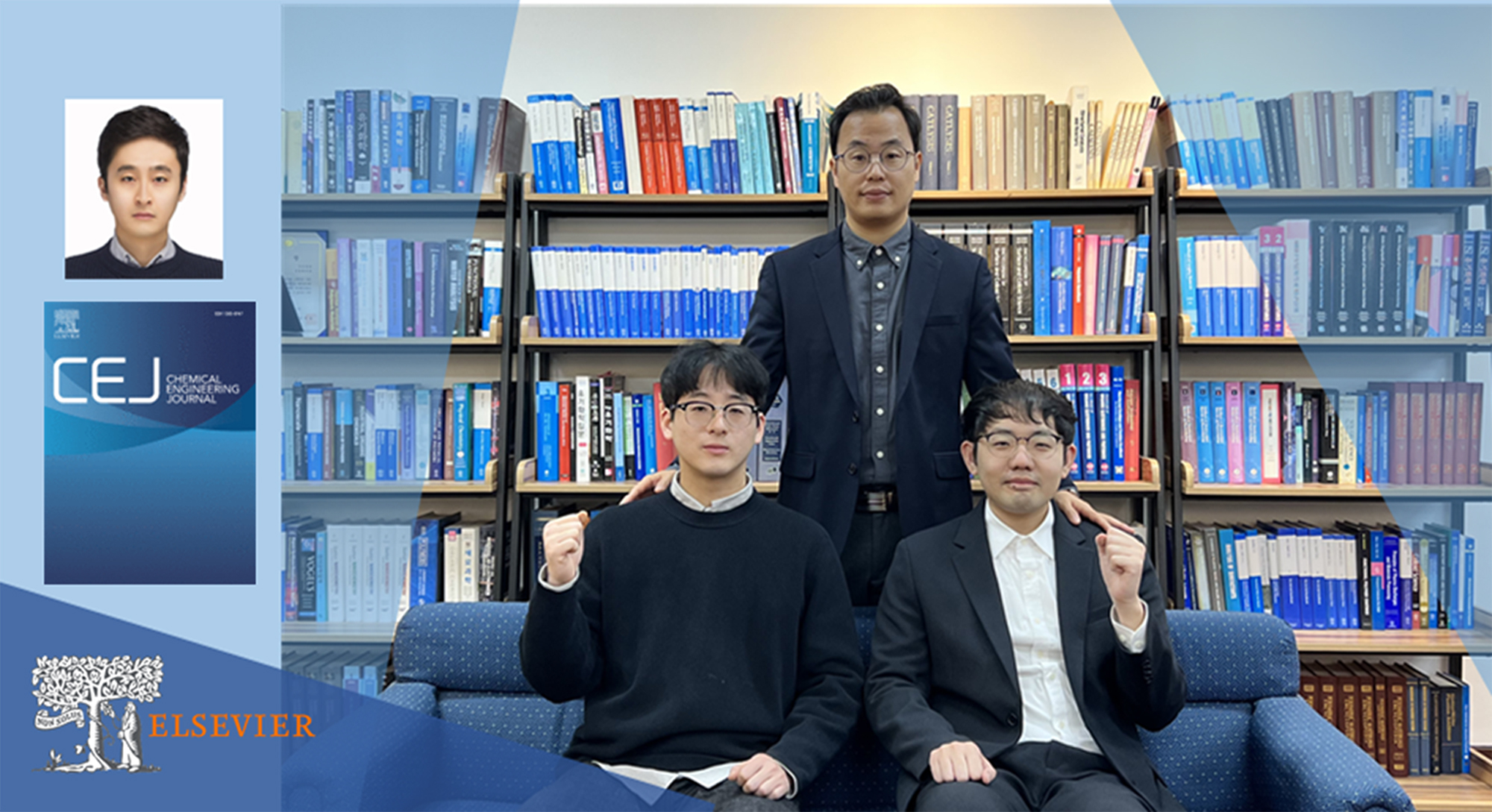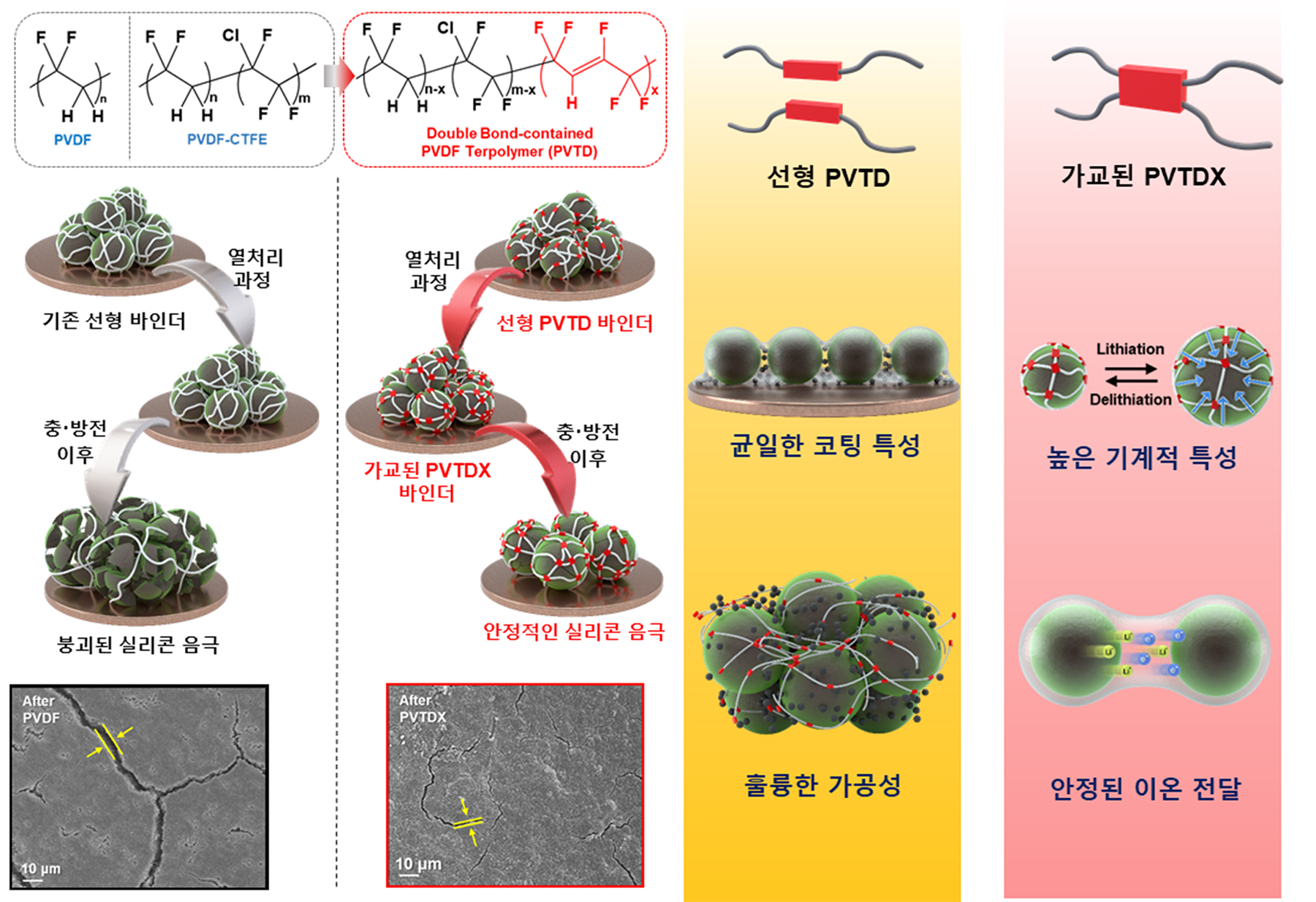커뮤니티
부경투데이
- 국립 부경대학교의 다양한 모습과 소식을 접하시면 부경대학교가 한번 더 가까워집니다.
| 국립부경대-부산대 공동연구 '주목'(Joint research between PKNU and PNU attracting attention) | |||
| 작성자 | 대외협력과 | 작성일 | 2024-02-05 |
| 조회수 | 384 | ||
| 국립부경대-부산대 공동연구 '주목'(Joint research between PKNU and PNU attracting attention) | |||||
 |
대외협력과 |  |
2024-02-05 |  |
384 |
국립부경대·부산대 연구팀, 고성능 실리콘 음극 전지 개발
- 조계용 교수 등 불소계 고분자 기반 가교형 공중합체 바인더 개발 적용
- 국제학술지 <Chemical Engineering Journal> 게재

△ 연구팀 사진(왼쪽부터 부산대학교 이진홍 교수, 김세훈 석사, 조계용 교수, 권영제 박사과정생)
국립부경대학교 조계용 교수(공업화학전공)와 부산대학교 이진홍 교수(유기소재시스템공학과) 공동연구팀은 폴리비닐리덴플로라이드(PVDF) 기반 가교형 바인더 소재를 적용한 고성능 음극 전지를 개발했다고 밝혔다.
연구팀은 이차전지 등 차세대 배터리에 사용되는 실리콘 음극재에 사용되는 삼차원 네트워크의 형태를 갖춘 불소계 고분자 물질 PVDF 기반의 가교형 공중합체 바인더를 개발해 이 같은 성과를 거뒀다.
현재 대표적인 전극 재료인 흑연 음극은 이론 용량이 낮아 이를 대신할 높은 용량을 지니는 차세대 전지의 전극 제작을 위해 실리콘이 유망한 음극 재료로 개발되고 있는데, 실리콘 소재는 충?방전 과정에서 부피 변화가 커 상업성이 낮은 한계가 있다.
이 같은 실리콘 음극의 안정성을 확보하기 위해 폴리비닐알콜, 폴리아크릴산 등 다양한 소재를 이용한 바인더가 광범위하게 연구되고 있지만, 바인더의 선형사슬이 부피 팽창 중에 발생하는 응력에 대한 저항이 낮은 단점이 있다.
연구팀은 이 같은 문제를 해결하기 위해 전기화학적 안정성이 높고 상용 전극 제조에 널리 사용된 불소계 고분자를 기반으로 삼차원 가교 네트워크를 적용, 실리콘 음극의 안정성을 향상시켜 전극용량과 사이클 수명을 증가시키는 데 성공했다.
이번 연구 논문의 제1 저자인 권영제 박사과정생은 “불소계 고분자 기반 가교성 공중합체 바인더는 향상된 유변학적인 특성과 더 나은 전해질 친화성을 보여주며, 실리콘 음극을 안정적이고 효과적으로 제작할 수 있게 해준다. 또 실리콘 음극의 입자 분쇄를 완화해 실리콘 음극의 안정성을 확보할 수 있다.”라고 밝혔다.
한편 이번 연구는 한국연구재단의 우수신진연구 및 산업통상자원부의 지원을 받아 수행됐으며, 연구결과를 담은 논문 ‘A stress-adaptive interlinked 3D network binder for silicon anodes via tailored chemical bonds and conformation of functionalized poly(vinylidene fluoride) (PVDF) terpolymers’는 국제학술지 <Chemical Engineering Journal>(IF 15.1, JCR 상위 3.2%)에 최근 게재됐다. <부경투데이>

△ PVDF 기반 가교성 공중합체 바인더를 통한 안정적인 전극구동의 모식도 및 특성 이미지.
PKNU and PNU joint research team have developed a high-performance silicon cathode battery
- prof. Cho Kie-Yong and others applied the development of a cross-linked copolymer binder based on fluorine-based polymers
- paper in the international academic journal <Chemical engineering journal>
The joint research team of professor Cho Kie-Yong (industrial chemistry) at Pukyong National University and professor Lee Jin-Hong (department of organic material science and engineering) from Pusan National University announced that they had developed a high-performance cathode battery using a cross-linked binder material based on polyvinylidene fluoride (PVDF).
The research team achieved this by developing a cross-linked copolymer binder based on PVDF, a fluorine-based polymer material in the form of a three-dimensional network used in silicon anode materials used in next-generation batteries such as secondary batteries.
Graphite cathodes, the electrode material currently in use, have a low theoretical capacity, so silicon is being developed as a promising cathode material to manufacture electrodes for next-generation batteries with high capacity. However, silicon materials have the limitation of low commercial viability due to large volume changes during the charging and discharging process.
To ensure the stability of the silicon cathode, binders using various materials such as polyvinyl alcohol and polyacrylic acid have been extensively studied, but the disadvantage is that the linear chains of the binder have low resistance to stress generated during volume expansion.
To solve this problem, the research team succeeded in improving the stability of the silicon cathode and increasing electrode capacity and cycle life by applying a three-dimensional cross-linked network based on a fluorine-based polymer that has high electrochemical stability and is widely used in the manufacture of commercial electrodes.
Doctoral student Kwon Young-Je, the first author of this research paper, said, "Cross-linkable copolymer binders based on fluorine-based polymers show improved rheological properties and better electrolyte affinity, and enable the stable and effective production of silicon anodes. At the same time, particle pulverization of the silicon anode can be alleviated to ensure the stability of the silicon anode."
The research was conducted with support from the National research foundation of Korea for Young researchers program and the Ministry of trade, industry and energy, and the research results have been published in a paper titled 'a stress-adaptive interlinked 3D network binder for silicon anodes via tailored chemical bonds and conformation of functionalized poly (vinylidene fluoride) (PVDF) terpolymers' in the international academic journal <Chemical engineering journal> (IF 15.1, JCR top 3.2%). <Pukyong Today>